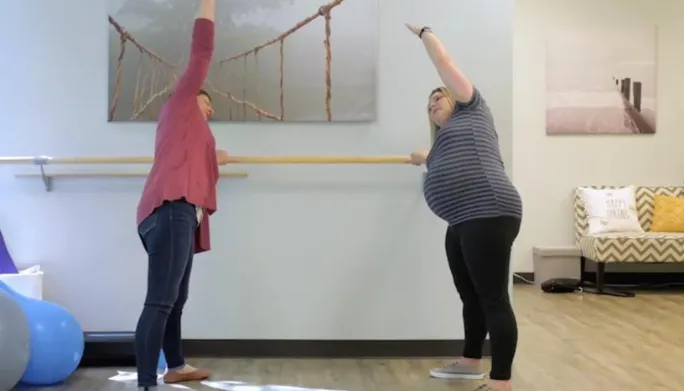Pregnancy is a beautiful and transformative journey for women, but it comes with its own set of challenges, especially when it comes to pelvic health. Understanding and proactively managing pelvic health during pregnancy is crucial for the well-being of both the mother and
the developing baby. In this comprehensive guide, we’ll explore the changes that occur in the pelvic region during pregnancy, common concerns, and effective strategies to navigate pelvic
health with confidence.
The Significance of Pelvic Health During Pregnancy
The pelvic region plays a pivotal role in supporting the growing uterus, accommodating the expanding baby, and facilitating a smooth delivery. As the body undergoes remarkable changes, it’s essential to prioritize pelvic health to ensure a comfortable and healthy pregnancy.
I. Understanding Pelvic Changes: The Journey Within

The journey begins with a profound transformation in the pelvic region. Hormonal shifts, increased blood flow, and the growing uterus all contribute to changes in the pelvic floor muscles, ligaments, and organs.
These changes are not limited to the pelvis alone. The low back and hip flexors will have an increased workload (and most likely begin to feel more tense/sore) and even our feet will possibly experience changes due to increased laxity/flexibility of the ligaments.
II. Common Pelvic Health Concerns During Pregnancy
A. Pelvic Girdle Pain (PGP):
Pelvic girdle pain (PGP) is a common condition that affects many individuals, particularly during pregnancy. It involves discomfort or pain in the pelvic region, making daily activities challenging. As the baby grows, the pelvic joints may become more flexible, leading to pain and instability. Common symptoms include:
- Pain in the Pubic Region: Feeling aching or stabbing sensations in the front of the pelvis. Often felt with stairs or turning in bed.
- Pain Across the Hips: Pain extending across the hips or the sides of the lower back.
Example: Experiencing a dull ache or sharp pain when moving from sitting to standing. - Difficulty Walking: Challenges in walking or taking stairs.
- Radiating Pain to the Thighs: Feeling aching or shooting pain down the legs.
It is estimated that about 50% of pregnant women experience PGP with 20% being significant enough to require the help of medical professionals to reduce and manage this pain.
Preventing and managing PGP will involve assessing for and treating asymmetries in mobility and strength of the hip, core, and lumbar spine, using a pelvic girdle or lumbar support braces, and other pain reduction therapies. Staying away from asymmetric strength exercises and asymmetric standing for prolonged periods can also help to reduce aggravation of pelvic girdle pain as well.
Pelvic therapists will use hands-on techniques to improve balanced joint mobility as well as prescribe core and hip strength exercises that can be done without increasing symptoms.
B. Urinary Incontinence:
Urinary incontinence, the unintentional leakage of urine, can occur due to pressure on the bladder as well as hormone changes. Some of my clients have recalled that they knew they were pregnant due to an increase in urine leakage with activity or sneezing when they had not been having issues before. For most, the increase in downward pressure and shifting in core and pelvic floor muscle strength and body alignment can be enough to tip the scales from no bladder issues to not having full control of leakage.
But before you assume that Kegels are needed, many of our clients over the years have found that their pelvic floor muscles were too tense. Treatment for them included helping them reconnect their breathing to their core muscles and reducing tension around their pelvis and hips. By the time they were in their 3rd trimester, they were leak-free!
Consulting with a pelvic therapist if leakage is occurring can help not only resolve the problem of leakage, but it can also help resolve pelvic floor issues that can drastically improve their birth experience and postpartum recovery. They will provide a thorough assessment to help each person discover the imbalances present and the appropriate plan to resolve them.
III. Strategies for Maintaining Pelvic Health During Pregnancy

A. Prenatal Exercises for Pelvic Health:
Prenatal exercises should focus on three primary goals. 1) Breath connection to the deep core 2) Improving mobility within the hips, spine, and pelvis 3) Improving or maintaining the strength of the core, pelvic floor, and hips/glutes.
- Well-coordinated breath connection helps us during labor to support our nervous system and pain management as well as to use our breath as a powerful tool for effective pushing.
- Mobile pelvis and hip joints will allow the baby to move through and out of the pelvis. This will also include pelvic floor muscles that are able to release and lengthen.
- Effective pushing will also require strong and coordinated deep abdominals to help the contracting uterus push the baby downward.
A well-balanced prenatal exercise program will include all three types of exercises. As individuals are highly varied in their exercise experience, there can be foundational exercises that work for most women, and then higher-level fitness exercises for those with more fitness experience if desired.
For the purposes of preparing for labor, however, exercises that result in excessive tension in the hips and pelvis are not ideal. The goal for labor is to be able to EASE our baby through our pelvis. Excessive tension can stall, prolong or even contribute to the inability to deliver vaginally without further interventions or needing a c-section.
B. Ergonomic Adjustments for a Healthy Pregnancy:
Ergonomic adjustments for working at a desk can include :
- A properly fitted chair with feet able to rest flat on the floor or use a small foot stool
- Avoid crossing your legs
- Top of computer monitor should be at eye level
- Keyboard should be at elbow height with elbows relatively close to your sides
- A lumbar support cushion or wedge seat cushion to reduce low back strain
- Taking frequent breaks to stretch or get up and walk around
Proper Lifting:
- Repeat after me: “When in doubt, stick your bum out!”. Hinging hips behind you is the safest way to reduce strain on your low back by helping you avoid tucking your tailbone under and using your low back.
- “Exhale with Effort”. Purse your lips and blow out while lifting a weight or getting yourself up from a chair or the floor. This helps you coordinate your deep core muscles and avoids putting more pressure downward on your pelvic floor.
- If you feel the need to hold your breath with lifting something, it’s probably too heavy. Grab someone to help you.
Sleeping Adjustments:
Sleeping with an ever-growing belly can be a challenge. Using pregnancy U-shaped large pillows to cradle you behind your back, between your legs, and around your belly is vital for most expecting moms to get a good night’s sleep. Many people also like individual pillows for between their knees and a small wedge for under the side of their belly for the last 1-2 months.
If pelvic girdle pain is prohibiting a person from being able to tolerate sleeping on their sides, some may even find that sleeping semi-reclined in a large armchair with a lot of pillows tucked around them to be helpful in the last 1-2 months.
Good Shoes:
With the pregnancy hormone changes leading to less ligament stability, feet can also benefit from a bit of help. Choosing footwear with better arch support can help you avoid the issue of feet becoming a size or two larger in width or length by the end of pregnancy. Arch support also provides better support for the hips and lower back which can help to reduce back and pelvic aches and pains.
IV. Seeking Professional Support: When to Consult a Pelvic Health Specialist

A. The Role of Pelvic Health Specialists:
Pelvic health specialists, such as pelvic physical therapists and occupational therapists, bring unique expertise to address concerns during pregnancy. Their specialized training allows them to understand the intricate changes in the pelvic region. These professionals empower pregnant individuals by offering personalized interventions, including pelvic floor exercises,
manual therapy, and tailored education. Beyond traditional medical care, they take a holistic approach, considering both physical and emotional aspects. With their deep knowledge of pelvic anatomy and compassionate approach, pelvic health specialists collaborate closely with pregnant individuals. By combining their expertise with a caring touch, they support and empower pregnant individuals through the challenges of pelvic health, fostering well-being during this transformative journey.
B. Pelvic Health Assessments During Pregnancy:
Pelvic health assessments during pregnancy offer valuable benefits by providing a comprehensive understanding of an individual’s pelvic well-being. Conducted by pelvic health specialists (PT/OT), these assessments aim to ensure optimal health and address potential concerns. During a pelvic health assessment, expect a supportive and informative environment where the specialist takes the time to understand your unique needs. The assessment may include discussions about your medical history, pelvic symptoms, and any discomfort you might be experiencing. Expect a gentle physical examination that evaluates pelvic floor function (tension, coordination, strength), joint mobility, and any signs of dysfunction.
These assessments adopt a proactive approach, aiming to identify issues BEFORE they become significant problems. This proactive stance enables early intervention and the implementation of personalized strategies, such as targeted exercises or lifestyle adjustments, to promote a healthier pelvic experience throughout pregnancy and beyond.
Embracing a Health Pregnancy Journey

Prioritizing pelvic health during pregnancy is a proactive step towards ensuring a healthy and comfortable journey. By understanding the changes in the pelvic region, addressing common concerns, incorporating supportive exercises, and seeking professional guidance, expecting mothers can navigate their pregnancy with confidence. Embrace the transformative journey and empower yourself with knowledge for a joyous and well-supported pregnancy experience.




